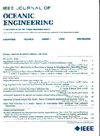Impact of Natural Turbulent Waters on Quantum Key Distribution: Temperature and Salinity Considerations
IF 5.3
2区 工程技术
Q1 ENGINEERING, CIVIL
引用次数: 0
Abstract
Quantum key distribution (QKD) has been identified as a viable solution for secure underwater communication. This study aims to characterize the impact of natural turbulent waters on systems. The performance of QKD systems is analyzed in terms of the quantum bit error rate and the secret key rate. We expand upon previous studies which only considered large separations by including large and small separations by comparing the turbulence length scale with the distance between two observation points. To that end, we obtain the analytical expression of the wave structure function (WSF) for small separation for propagating Gaussian beams. Since the WSF describes how the amplitude and phase of an optical wave change as it travels through the varying refractive index of the turbulent medium over a given distance, the accurate characterization remains essential in terms of revealing the beam wavefront distortion. Leveraging the practical parameters of underwater environment and communication systems, we demonstrate that the average temperature, average salinity concentration, temperature-salinity gradient, temperature and energy dissipation rates of turbulent water impact the performance and security of the QKD systems to a nonnegligible extent. It is also observed that the waters having high chlorophyll concentrations, e.g., coastal waters, drastically decrease the performance of the QKD systems due to strong absorption and scattering effects. The findings and insights gained from this study may help advance secure underwater communication, which in turn will aid in establishing future QKD networks. Potential applications of this research include secure underwater communication for defense, data gathering for marine environmental monitoring, remote data transmission, and deep-sea exploration.自然湍流水对量子密钥分布的影响:温度和盐度的考虑
量子密钥分发(QKD)已被确定为一种可行的水下安全通信解决方案。本研究旨在描述自然湍流对系统的影响。从量子比特误码率和秘密密钥率两个方面分析了量子密钥分配系统的性能。通过比较湍流长度尺度与两个观测点之间的距离,我们扩展了以前只考虑大分离的研究,包括大分离和小分离。为此,我们得到了传播高斯光束的小间距波结构函数的解析表达式。由于WSF描述了当光波在给定距离上通过湍流介质的不同折射率时,光波的振幅和相位是如何变化的,因此在揭示光束波前畸变方面,准确的表征仍然是必不可少的。利用水下环境和通信系统的实际参数,我们证明了湍流水的平均温度、平均盐度浓度、温度-盐度梯度、温度和能量耗散率对QKD系统的性能和安全性的影响是不可忽视的。还观察到,叶绿素浓度高的水域,例如沿海水域,由于强吸收和散射效应,大大降低了QKD系统的性能。从这项研究中获得的发现和见解可能有助于推进安全的水下通信,这反过来将有助于建立未来的QKD网络。该研究的潜在应用包括用于国防的水下安全通信、用于海洋环境监测的数据收集、远程数据传输和深海探测。
本文章由计算机程序翻译,如有差异,请以英文原文为准。
求助全文
约1分钟内获得全文
求助全文
来源期刊

IEEE Journal of Oceanic Engineering
工程技术-工程:大洋
CiteScore
9.60
自引率
12.20%
发文量
86
审稿时长
12 months
期刊介绍:
The IEEE Journal of Oceanic Engineering (ISSN 0364-9059) is the online-only quarterly publication of the IEEE Oceanic Engineering Society (IEEE OES). The scope of the Journal is the field of interest of the IEEE OES, which encompasses all aspects of science, engineering, and technology that address research, development, and operations pertaining to all bodies of water. This includes the creation of new capabilities and technologies from concept design through prototypes, testing, and operational systems to sense, explore, understand, develop, use, and responsibly manage natural resources.
 求助内容:
求助内容: 应助结果提醒方式:
应助结果提醒方式:


